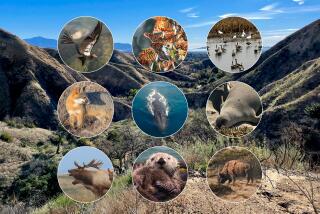The Sound of Wings Flapping
- Share via
GRIDLEY — We camped near the lake, and in the morning I was awakened by a noise like the rush of a distant railroad train. I saw a long line of fluttering white in the far distance which represented, I found, an immense body of wild geese. . . .
--New York journalist Charles Nordhoff, in an 1873 travel guide to California
It was dusk at Gray Lodge. To the south, the formidable Sutter Buttes were silhouetted against a sky streaked with lavender and orange, the last remnants of a sunny day. A half moon shone overhead, illuminating the marshes and ponds. On every piece of water, geese and ducks and herons were squeezed together, impossible numbers of birds, bobbing up and down, looking like a flotilla of rubber ducks at some bathtub Dunkirk.
The birds had flapped down the Pacific Flyway to wait out winter here at the state’s Gray Lodge wildlife preserve on the outskirts of Gridley. Gridley, to the uninitiated, is located in the north Sacramento Valley. It’s just south of Biggs, up by Tierra Buena, west of Honcut, over from Live Oak. . . . Anyway, the birds know the spot.
They were preparing now to fly out for their nightly feed. In an early winter so warm it’s been spooky, this has become the pattern of the Gray Lodge inhabitants. They hole up all day in the sanctuary, soaking up the sun and avoiding the hunting fields that surround it. This year they’ve been taking wing only under cover of darkness. It drives the duck hunters nuts.
The effect produced by this mass fly-out, the preserve manager had promised, is a marvelous sight--a spectacle “like nothing you have ever seen before.” And so at sunset I drove into the middle of the 8,000-acre preserve, parked beneath a cottonwood and waited.
*
The manager of Gray Lodge is R.B. Reno. He said R.B. stands for R.B., “nothing else: My folks were from Texas.” Reno is 61 years old, with silver hair and a farmer’s well-worn hands. When he smiles, he resembles Andy Griffith. He smiles often. Reno just might have the best job in California: “I can’t think of any other I’d rather have,” he acknowledged.
This was in the early afternoon, hours before the fly-out. Reno was driving me around. He stopped his pickup and slapped the roof. A couple thousand pintails and mallards flushed from the reeds and wheeled into the air. It was as beautiful a sight as I had ever seen in California. Reno just smiled.
He has been manager for 16 years, only the third Fish and Game official to hold the position since the state took over the old Gray Lodge duck club half a century ago. Reno and a small crew are responsible for what has become the most heavily trafficked winter site on the Pacific Flyway. They plant and plow and move water about like farmers, creating a landscape of marshes and woods that recalls the raw California captured by naturalist painters in the late 1800s.
That celebrated school of artists, of course, had all California as its canvas. Gray Lodge encompasses 13 square miles, a relative postage stamp. Still, it’s enough to fire the imagination about what once was in this state, and not so long ago. Of course, it was tough back then finding decent drive-through.
*
In a good year, more than a half million birds winter at Gray Lodge. This is shaping up as a very good year. After years of decline, the Pacific Flyway bird count has exploded, from a low of 20 million in 1990 to something like 80 million waterfowl. Duck hunters, ecologists, farmers, policy-makers--the list of those taking credit for the turnaround is long. The main thing, though, as Reno explained, is that last year finally it rained a whole bunch.
By day it can be difficult to grasp how many birds are in the sanctuary; many are hidden by ground cover. The fly-out, I was assured, would make the point. The spot Reno had directed me to was isolated, but hardly quiet. Birds squawked, honked, cackled, screeched, quacked, interrupting one another, demanding to be heard. It reminded me somehow of American talk radio.
Now there came a different sound. A whup, whup, whup that initially I mistook for a helicopter. It was the sound of wings flapping. Many wings. This was followed by a great splashing of webbed feet and much honking, and a whole city of birds lifted off as one. The sky was clouded with them. It was startling, marvelous, unforgettable. Birds flew in every direction, dodging and ducking and sometimes colliding midair. After a few chaotic minutes, they organized themselves in familiar V-formations and flapped off into the night, gone. Show over, I headed for home, wearing one of R.B. Reno’s smiles.
More to Read
Sign up for The Wild
We’ll help you find the best places to hike, bike and run, as well as the perfect silent spots for meditation and yoga.
You may occasionally receive promotional content from the Los Angeles Times.







